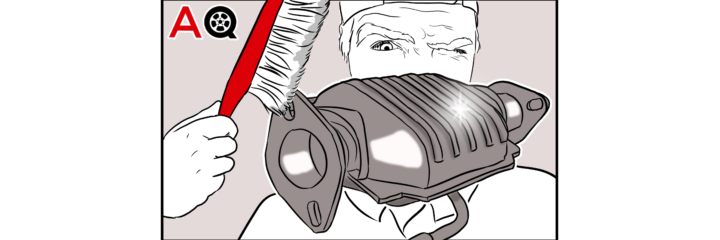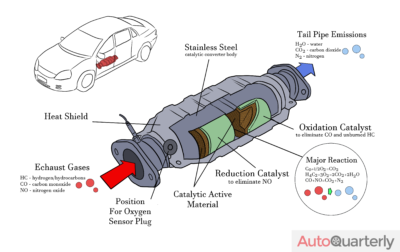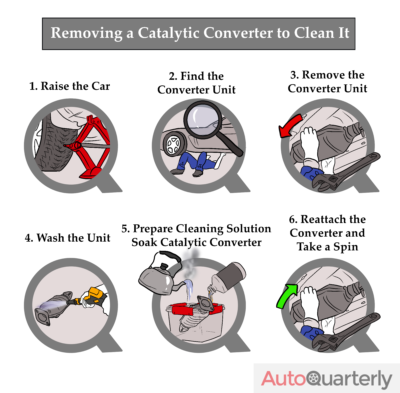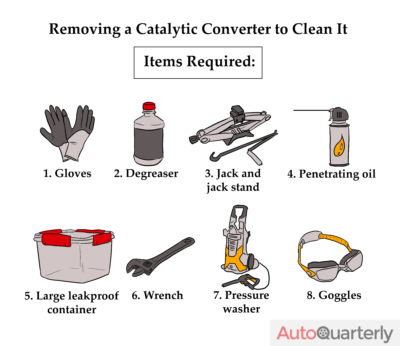A catalytic converter that’s in good working order is to keep your car running well. Keeping your catalytic converter in good condition is good for the environment, necessary for reducing emissions, and required by law in many places. Today, we’ll find out how you can keep your catalytic converter clean so that it can, in turn, keep the environment clean.
Before we get to how you can go about cleaning a catalytic converter, let’s take a moment to understand what they do and why it’s essential to keep them clean in the first place.
What Do Catalytic Converters Do Anyway?
Catalytic converters are like little chemistry labs in the underbelly of your car. They carry out a myriad of chemical reactions while you drive around. The purpose of those chemical reactions? Reducing the harmful emissions from your car.
Cars run on chemical reactions that produce some noxious gases. That includes gases like nitric oxide, carbon monoxide, and nitrogen dioxide. The job of the catalytic converter is to turn these harmful byproducts of the internal combustion process into something that’s a little more palatable for the environment, typically water vapor and carbon dioxide.
In order to achieve what they’ve set out to do, catalytic converters need to run at temperatures as high as 750 degrees Fahrenheit. To make this possible, catalytic converters used to be placed near the engine, so they can you of its heat. But that was problematic due to the wear and tear on and inconsistent heat on that area, so this component has moved further down the transmission chain.
Why Keep the Catalytic Converter Clean?
Catalytic converters play a key role in the functioning of your car. Let’s take a look at all the reasons why you should care about catalytic converter maintenance.
Reduced Emission Levels
We don’t need any more harmful emissions going out into the atmosphere, and catalytic converters help keep the most harmful of emissions in check. Modern converters do a great job of cleaning most of the harmful gases coming from the engine. So if you want to drive your car around in a way that makes Captain Planet happy, keep that catalytic converter well maintained.
Passing Emissions Tests
The government cares about cars being environment-friendly, too. That’s why you need to pass emission tests in order to be road-legal. If you’ve got a car that’s up for an emission test, cleaning the catalytic converter and ensuring it’s working can help you make the grade, along with insurance, the rest of your vehicle is in good working order.
Enhanced Engine Performance
This is something every gearhead cares about. A clean catalytic converter also means an engine that is more likely to perform the way you want it to. That’s because when you clean the system, it has positive secondary effects on the fuel injection system, also making cylinders are cleaner overall. That leads to lesser fuel consumption and better performance.
Reduce Smells
Catalytic converters keep your car clean in the chemical sense, but they also keep them free of bad smells. A converter that isn’t clean is one that gets clogged up with particulate matter. This leads to the classic rotten egg smell that is characteristic of Sulfates and similar compounds. Keeping the converter clean can keep your car from smelling like a machine shop.
Save Money
Due to the small quantity of platinum used in a catalytic converter, the part can cost a lot of money. If you let your converter build up with impurities, you will reach a point where it needs to be replaced. If you don’t want to get to that point, you need to keep it clean.
Another way in which catalytic converters save you money is by keeping the engine working well, as discussed earlier. An engine that’s in order is one that doesn’t need to go in for maintenance often, another way in which you save money.
It’s pretty evident that a catalytic converter clean is a good idea. But don’t go running off to get to work on your converter just yet. There are a few things you need to know before you can clean it the right way.
Things to Check Before Cleaning a Catalytic Converter
Due to the chemicals, sharp metals, and harsh substances involved with motor vehicles to exercise some caution before cleaning your catalytic converter, make sure you’ve run through this checklist before cleaning.
Check for Loose Parts
It is possible that some of the parts within your catalytic converter have come undone. An easy way to find out is to whip out a rubber hammer and give the converter a few good knocks. If you hear any jangling coming from inside, that means that there could be some loose parts within.
If it sounds like you have loose parts, then it’s best to take your catalytic converter off your car and clean it. This gives you a chance to check if any parts inside have become so loose that they might block the exhaust. That’s a scenario you really don’t want, so check how loose parts are before going forward with the cleaning.
Check for Internal Leaks
In certain cases, catalytic converters have oil leaks internally. If that’s the case, then you need to address the oil leak before going forward with the cleaning. If you don’t, the cleaning is a futile exercise.
There are a few signs you can look for to find out whether the converter has fallen prey to an oil leak. Start by checking the crankcase ventilation to make sure that it is not blocked. Next, take a look at the valve seals and piston rings to make sure that there’s no breakage in their body.
Excessive Clogging
If your catalytic converter has become clogged to such an extent that the engine won’t run properly, then you have to take the part off to clean it. It is possible that your catalytic converter is too far gone and needs replacement. But always first take it off and do a thorough cleaning to see if it can be revived.
Those are some of the checks you need to make before carrying on with your catalytic converter’s cleaning. Once you’ve made those checks, it’s time to get that converter squeaky clean. You can do that both without removing it from the body of your car and by removing it. We will go through what each of those methods looks like.
Cleaning a Catalytic Converter Without Removing It
Ideally, you wouldn’t have to remove your catalytic converter to clean it. That just makes the process easier and quicker. Here are two ways you can get that done. And the only thing that’s required? Catalytic converter cleaner, which you can pick up at most auto parts stores.
The easiest way to clean a catalytic converter is by spraying it with a cleaner. Here are the steps you need to follow to clean the component using this method.
1. Purchase a Compatible Catalytic Converter Cleaner
Catalytic converter cleaners are usually compatible with only one fuel type. If you own a gasoline car, then you need a cleaner that works with gasoline cars. The same goes for cars that have diesel engines.
There are some catalytic converter cleaners that work with both gasoline and diesel engines. This cleaner by Cataclean is one example. Just make sure to read the label so as to not use the wrong cleaner for your fuel type.
2. Pour the Product Into the Tank
The volume of cleaner that you will require depends on the size of your car. The larger your car is, the larger the size of the catalytic converter. Make sure you have enough cleaner to complete the cleaning process depending on the size of your car. The bottle of cleaner you purchase should have details around the amount of cleaner you should use.
Most products require you to have a near-empty tank before pouring in the cleaner. Check the instructions on the product to find out where your tank levels need to be. After you’ve checked that, you can pour the cleaner straight into the tank.
3. Drive Your Vehicle
You can now proceed to drive your car as you would usually. When you do that, the cleaner will circulate through the car in the same way that the fuel does. Most cleaners will mention how many miles or how much driving time you need to cover before you get results, yielding a cleaner catalytic converter.
Removing a Catalytic Converter to Clean It
Item(s) Required:
- Gloves
- Degreaser
- Jack and jack stand
- Penetrating oil (like B’laster)
- Large leakproof container (for the catalytic converter)
- Wrench
- Pressure washer
- Goggles
1. Raise the Car
Before lifting the car, ensure that it has cooled down. As we said earlier, the converter functions at temperatures of around 750 Fahrenheit, so you need it at a safe temperature before working on it. If you’re doing this first thing in the morning, then you’ll be fine. If not, wait a couple of hours before working on your car.
2. Find the Converter Unit
Catalytic converters usually sit near the exhaust pipe on a car. They tend to have a round or square shape as shown in the image below.
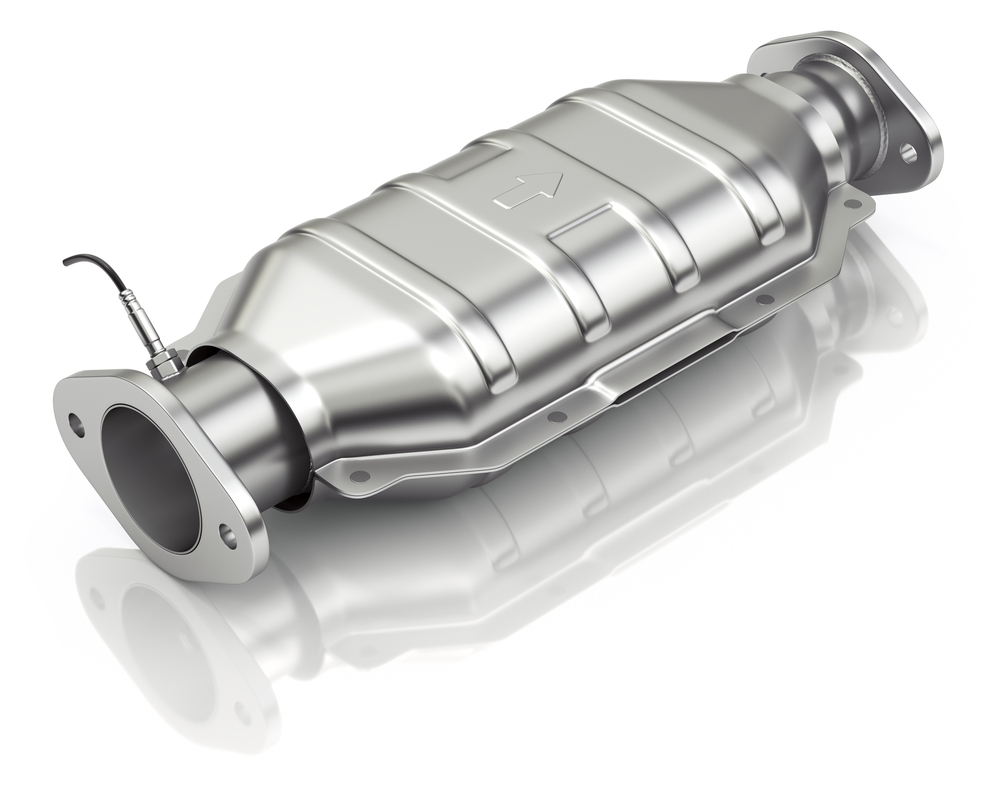
When you find the unit, you will be able to tell whether it is bolted or welded onto the body of the car. If it’s the former, you can easily undo the bolts to take the converter off the body. If it is welded, then you will most likely need a mechanic’s help to complete a cleaning process. Due to their high price, many catalytic converters are welded on to prevent theft.
3. Remove the Converter Unit
If the unit is bolted on, then you can start undoing the bolts starting from the back and moving towards the front. That is, you start from the bolt that’s closest to the exhaust and work your way in the other direction. Undo the bolts slowly and make sure to support the unit so that it doesn’t come crashing down. The oxygen sensor unit will also come off at this point.
4. Wash the Unit
Once the unit is off, you can wipe its body off in a cursory fashion so as to not contaminate the interior later on. Grab your pressure washer and set it to a low-pressure level. Run it over the entire body, including the outlet and inlet areas, to eliminate all the accumulated crud.
5. Prepare Cleaning Solution and Soak Catalytic Converter
To prepare the cleaning solution, fill a container with hot water and mix it with degreaser. You can let the catalytic converter sit in this solution for up to an hour. Repeat the rinsing process with your power washer to get all of the solution off the unit.
You have to make sure that your converter is completely dry before you put it back onto your car. We’d probably recommend leaving it to dry overnight before proceeding to the final step.
6. Reattach the Converter and Take a Spin
After the catalytic converter has been washed off the cleaner solution and dried, it can be reattached to the car’s body. Get the oxygen sensor back on there as well.
Once all that is done, it’s time to take your car for a spin. If everything has gone to plan, you should be able to start it immediately and notice that all of the symptoms, like engine misfires or a bad smell, have drastically reduced or gone away completely. You can check the efficacy of your work with an emissions test.
Final Thoughts
Keeping your catalytic converter clean is quite an easy process if you don’t have a welded converter, and can save you a lot of money. Cleaning your converter is a lot cheaper than getting a replacement.
In many cases, the simplest way to clean the unit is to add a cleaner to the gas tank, meaning you won’t have to remove the part. Always check for loose parts if you do decide to take the converter off the car. Either way, the task can be accomplished by an amateur mechanic and will save both the environment and your pocketbook.
